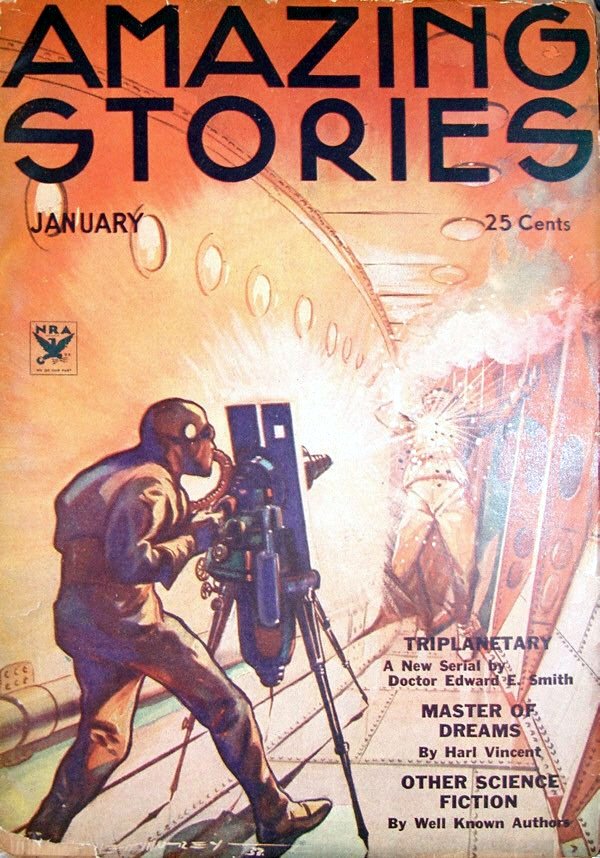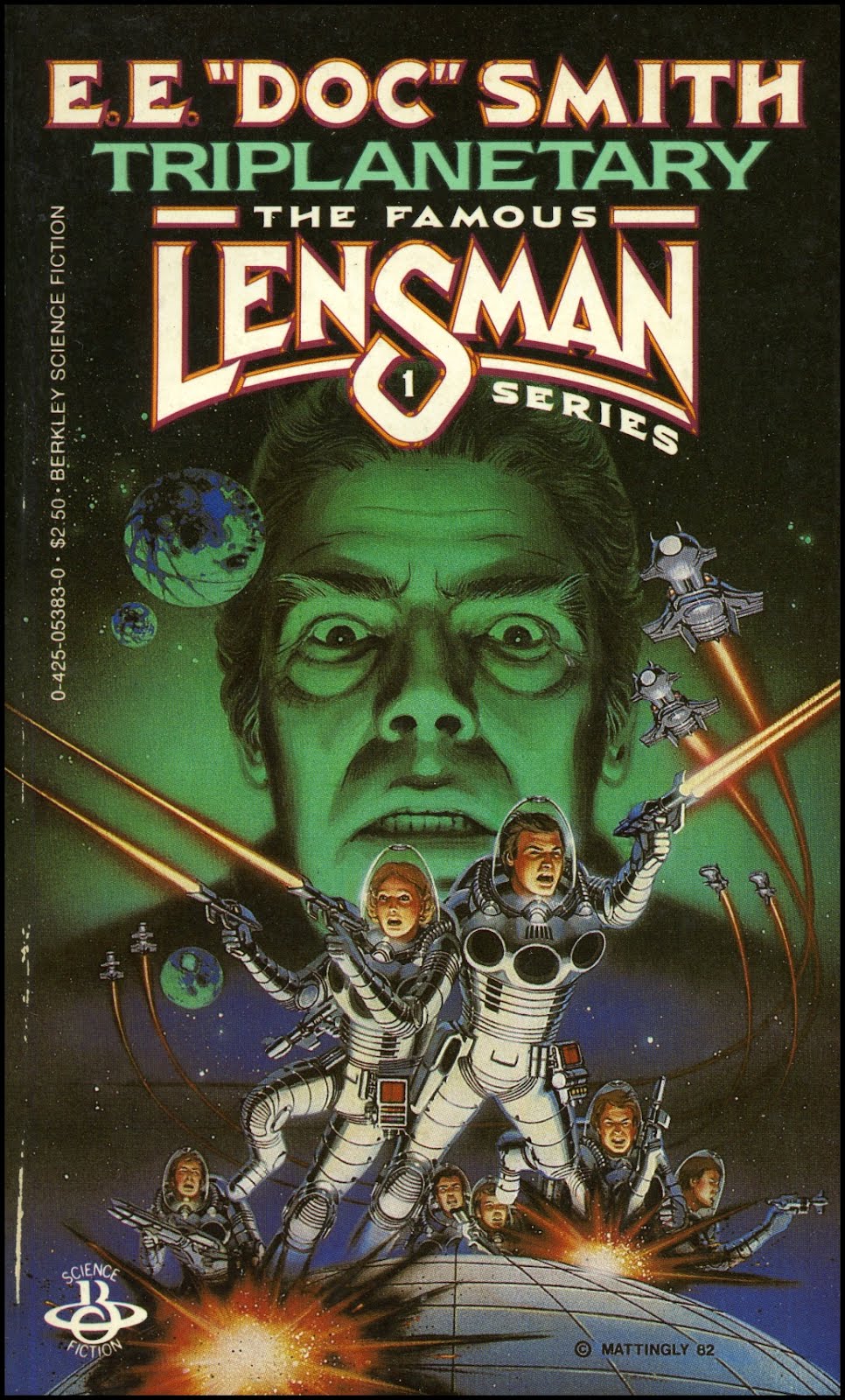E.E. Smith: The Doc Is In
Saturday , 27, May 2017 Before the Big Three, Book Review, Fiction 17 CommentsLast week was #SpaceOperaWeek, so I’m a bit late to the party. Still, any time is a good time for space opera!
Being a relative newcomer to both Appendix N and the pulps is a mixed bag. On the one hand, oh man – what an embarrassment of riches! Of what I’ve been able to get my hands on, so much has been awesome sauce! What’s fallen short of that empirical benchmark has at least been somewhat educational, as a fan of SFF. On the other hand, what a glut! What a dilemma of choice! Do I keep reading all these kickass Jack Vance stories, or check out this C.L. Moore everyone has been talking about? And there are all those Edgar Rice Burroughs series just waiting to be read! Sometimes it makes my head spin.
One name I keep coming across, an early titan of science fiction, is E.E. “Doc” Smith. I’ve not read much about his stories or style (aside from “action-packed!), but wise men have observed the breadth of his influence in inspiring games like Traveller and paving the way for cultural behemoths like Star Wars. I believe someone last week went to far as to call him the progenitor of the space opera. 
Well, I finally got around to reading Triplanetary, the first of his Lensman books. And I would recommend it as required reading for any serious fan of the genre.
Interestingly, the thing that struck me the most about Triplanetary was not its action (though it’s got plenty of that, for sure). It was Smith’s aliens. Maybe it was Brian Niemeier’s recent Geek Gab episode about nonhuman characters that had me focusing in on this, but I was struck by how interesting they were. The two “prime” alien races – the powerful and transphysical Eddorians and Arisians are mysterious and compelling in their own rights, but the amphibious Nevians, with their monstrous forms, strange technology, and inhuman rationality really drew me in. I finished the book wanting to know more about all three nonhuman peoples.
If you’re sick of elves and dwarves in space and giant alien bugs, the lifeforms of Triplanetary may cure what ails you. If you’re a fan of action – daring escapes, space armor, and ship battles, you’ll have fun. If you love stories of uber-competent men being men, you’ll enjoy this one.

I didn’t find the first Lensman installment to be a perfect work (for what is perfect?). Disbelief must need be suspended at certain points to advance the story. For instance, there was one part where our hero escapes with his woman and buddy, and as they realize they have no fuel, he produces a bootful of molten iron (which the escape vessel accepts to produce energy) with only the explanation that he pilfered it from their captors. Nevermind the fact that nowhere in the narration was such an opportunity overtly evident. Nor could I figure out how both his foot and the liquid iron were able to both occupy his boot. Still, it wasn’t story-breaking, so nothing to do but raise an eyebrow and move on. Thankfully I didn’t discover this kind of odd plot contrivance to be a common occurrence.
Triplanetary is just a small spoonful of Doc Smith’s medicine, and I’ll be glad to pick up with him at some point in the future. For now, with so much literary wealth to get to, all I can do is heartily recommend checking out his stuff.
PCBushi can also be found on Twitter or at the PCBushi blog, where he ruminates on scifi/fantasy, games, and other spheres of nerd culture.
The iron was not molten as such, but some allotrope of the element which was liquid e.g.
“Without waiting to investigate the nature, appearance, or structure of the precious mass, Nerado ordered power into the converters and drove an enormous softening field of force upon the object–a force of such a nature that it would condense the metallic iron into an allotropic modification of much smaller bulk; a red, viscous, extremely dense and heavy liquid which could be stored conveniently in his tanks.”
You might say that the Nevians use “red mercury” as their fuel.
-
Further to this, a few pounds of allotropic iron was sufficient to power Nerado’s entire vessel, so having a few pounds in your boot isn’t too unreasonable. I certainly agree that the plot hole was where/how he got it though.
FWIW, the usual recommended reading order is to start at Galactic Patrol and get to Children of the Lens before you go back to Triplanetary & First Lensman. Means you avoid some plot spoilers and the like.
Wait until you get to the Galactic Patrol. This is when Lensmen really comes into it’s own. Great stuff.
-
+9000
Skylark 3 and Skylark of Valeron are epic space novels, I read them as a boy and always thought them better than Star Wars.
TRIPLANETARY is the ‘first’ Lensman book in just the same way that MAGICIAN’S NEPHEW is the first Narnia book, or PHANTOM MENACE is the first Star Wars movie.
I strongly recommending reading the books in their publication order, not chronological order.
The prequels were written later, and added into the cannon under the assumption that the reader already knew things that were surprises and plot twists in the later books.
GALACTIC PATROL first, the GRAY LENSMAN, SECOND STAGE LENSMAN, CHILDREN OF THE LENS, and only read FIRST LENSMEN if you are hungry for more. VORTEX BLASTER is inferior, and can be safely skipped by all but those who insist on reading for the sake of completeness.
The books by David A. Kyle (Z Lensman, Dragon Lensman, Lensman from Rigel) can be safely skipped.
-
Agreed on all points.
FIRST LENSMAN is basically a spoiler-filled, novel-length retelling of the Academy Commandant’s speech to the graduating class in the first chapter of GALACTIC PATROL. Well worth reading, but it’s a prequel, not the beginning of the series.
-
Let us clarify “publication order” for the Lensman books.
The original magazine version of Triplanetary did indeed appear before Galactic Patrol, but that version was not part of the Lensman universe. The series as originally conceived began in magazine with Galactic Patrol and continued through Children of the Lens. When it came time to publish the series in hardback, Doc expanded and modified Triplanetary to fit into the universe of the Lens and wrote First Lensman to bridge the gap between Triplanetary and Galactic Patrol. As JCW says, the mainline of the series begins with GP; you should start there and read the prequels and side-bar series only if you cannot get enough Doc Smith.
NOTE: Project Gutenberg has both version of Triplanetary available. The magazine (non-Lensman) version has the Amazing Stories cover; the book version has one of the paperback edition carver.
The GURPS Lensman sourcebook is interesting too – I can’t tell if the authors of that are sincere in trying to pay true homage to the series, or are satirizing it – they apologize for the sexist tone of the original series, but they remind readers of the time frame it was written in, rather than attack Doc Smith or his contemporaries – they at least attempted to split the difference…